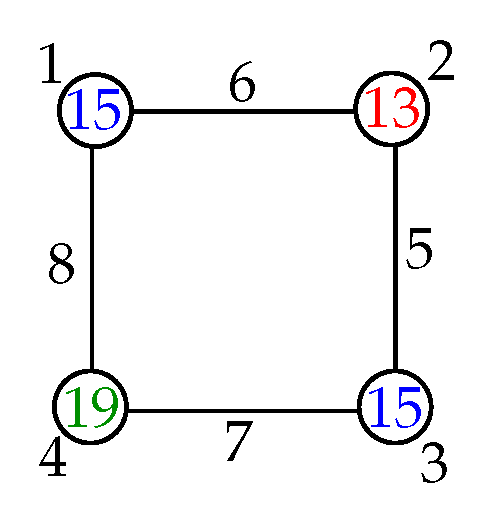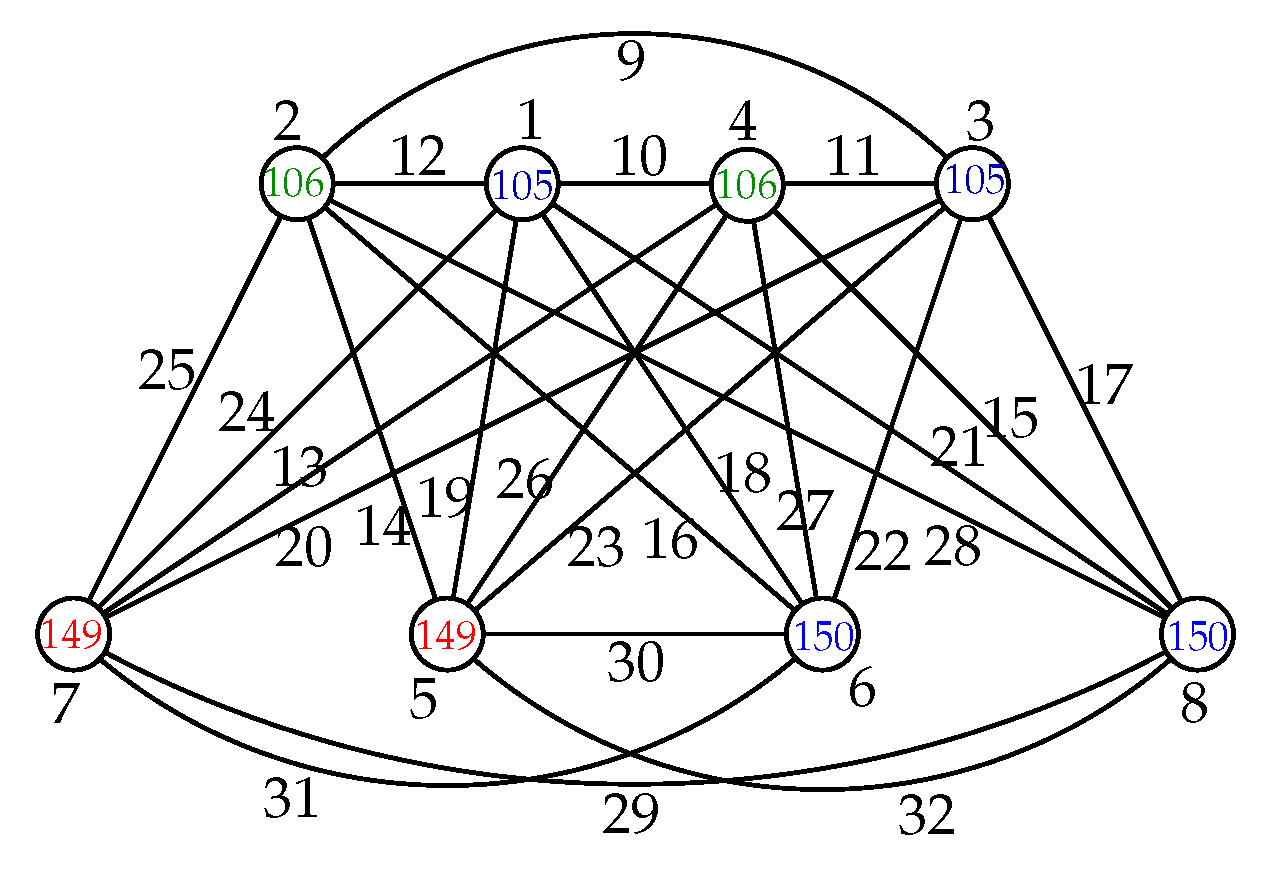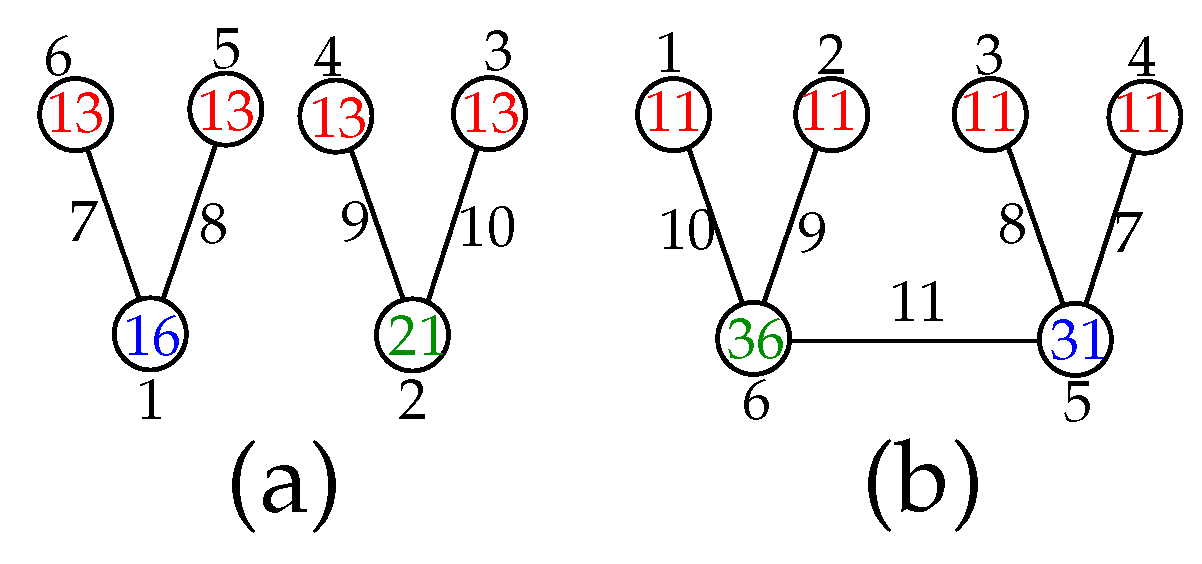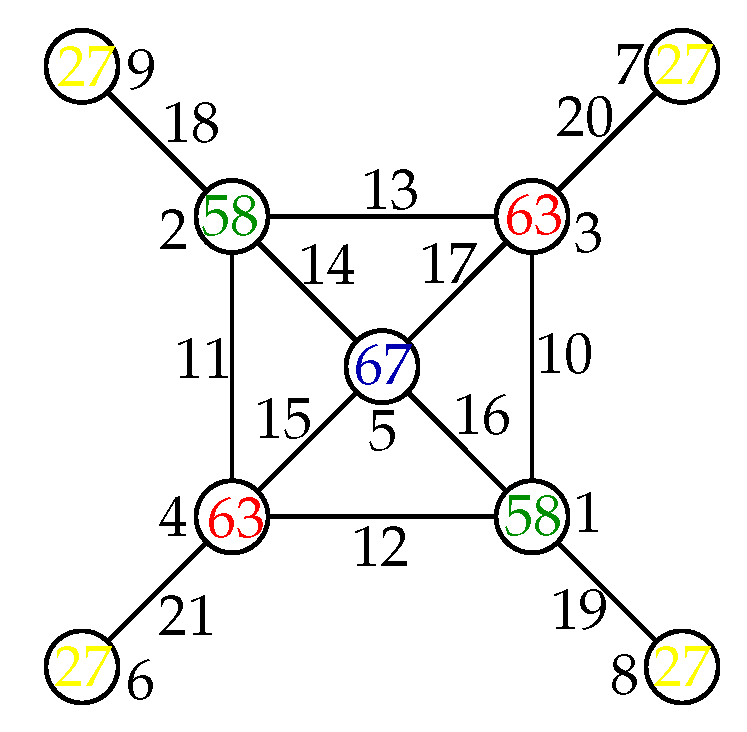1. Introduction
Vertex coloring is an assignment of colors to every vertex of graph
G such that any two adjacent vertices receive different colors and the number of colors used for such coloring is made as minimal as possible. The vertex coloring problem has many applications such as a scheduling system [
1] and frequency allocation.
Formally the vertex coloring in a graph is defined as follows. The
k-coloring of graph
G is a map of
where
V is the set of vertices of
G and
is a color of vertex
v such that
whenever vertices
u and
v are adjacent. The smallest positive integer of
k is such that
G satisfies the
k-coloring and is called the
chromatic number of
G, denoted by
[
2].
The vertex coloring of graphs is then approached by using the local antimagic total labeling of a graph. In 2017, Arumugam, Premalatha, Bača, and Semaničová-Feňovčíková [
3] introduced this concept and defined it as follows. The
local antimagic total labeling on a graph
G with
vertices and
edges is defined as a bijection
such that the weights of any two adjacent vertices are different, that is,
where
and
is the set of edges incident to
u. Thus, any local antimagic total labeling of a graph
G induces a proper vertex coloring of
G where the weight
is assigned as the color of vertex
u. The local antimagic chromatic number of
G, denoted by
, is the minimum number of colors taken over all colorings induced by local antimagic total labelings of
G.
The local antimagic chromatic number of some families of graphs are presented in the paper [
3]. These include the complete graph
for
, the star
for
, the path
for
, the cycle on
n for
, the friendship graph
for
, the complete bipartite graph
for
, and the wheel
for
. Nazula, Slamin, and Dafik [
4] determined the local antimagic chromatic number of uni cyclic graphs. Arumugam, Yi-Chun, Premalatha, and Tao-Ming [
5] discovered the local antimagic chromatic number of the corona product of two graphs such as paths, cycles, and complete graphs with other graphs.
Recently, Putri, Dafik, Agustin, and Alfarisi [
6] extended this notion by labeling the vertices and edges of a graph
G to establish a vertex coloring. The local vertex antimagic total labeling on a graph
G with
vertices and
edges is defined to be an injective assignment
so that the weights of any two adjacent vertices
u and
v are distinct, that is,
where
and
is the set of edges incident to
u. For local antimagic total labeling, any local vertex antimagic total labeling of a graph
G induces a proper vertex coloring of
G where the vertex
u is assigned by the color
. The
local antimagic total chromatic number, denoted by
, is the minimum number of colors taken over all colorings induced by local vertex antimagic total labelings of
G. It is easy to see that for any graph
G,
. The local antimagic total chromatic number for some family of graphs have been established by several authors such as prisms and Möbius ladders [
7], brooms [
8], stars [
6], wheels, fans, and friendship graphs [
9].
In the local antimagic total labeling of graph
G, if the vertices of
G receive the smallest labels, that is,
, then it is called
local super antimagic total labeling. Any local super antimagic total labeling also induces a proper vertex coloring of
G where the vertex
u is assigned the color
. The
local super antimagic total chromatic number, denoted by
, is the minimum number of colors taken over all colorings induced by local super antimagic total labelings of
G. Again it is easy to see that for any graph
G,
. Pratama, Setiawani, and Slamin [
10] determined the local super antimagic total vertex coloring of some wheel-related graphs such as fans, even gear graphs, and sun flower graphs. In this paper, we determine the local super antimagic total chromatic number of some families of graphs such as stars, double stars, paths, cycles, gears, suns, helms, wheels and, some graphs obtained from an amalgamation product.
2. Results
We start this section with the upper bound on the chromatic number of the local super antimagic total of a tree as described in the following theorem.
Theorem 1. If T is a tree on vertices with k leaves, then .
Proof. Let T be a tree on vertices with k leaves. Let be some vertices in T that are adjacent to leaves, namely, , where , , . Label the leaves for by if and if and label the edges with using formula to obtain . The rest of the edges are labeled by such that , for each and where is the sum of all labels of edges that are incident to the vertex . Label vertex by x and vertex by y, where for . The weight of leaves are obtained from the smallest labels of vertices and edges. Thus, the total labeling of f produces for each , where . It is clear that the weight of vertices are different whenever they are adjacent. Therefore the local super antmagic total labeling f gives . □
Star, denoted by , is a special class of tree of order with n leaves. By using Theorem 1 and the fact that for any connected graph G of order of at least 2, we obtain the local super antimagic total chromatic number of the star as follows.
Corollary 1. If is a star, then .
Double star, denoted by , is another special class of tree of order with n leaves and two central vertices that are adjacent to k and leaves, respectively. By using Theorem 1 and a local super antimagic total labeling, we obtain the local super antimagic total chromatic number of the double star as follows.
Corollary 2. If , for and , is a double star, then .
Proof. Let , for and , be a double star of order with n leaves. Let and be two central vertices of the double star , where is adjacent to k leaves, say , and is adjacent to leaves, say . For and , the double star or is isomorphic to path . It is easy to check that , so . Combined with Theorem 1, it implies that . We now suppose that for and . Then there must be two vertices of distance two with the same weight. Without loss of generality, suppose that for any and where is the degree of central vertex . Since the smallest labels are used for vertices and the three smallest edge labels are , , and , it implies that . However, the weight of for any is obtained from the sum of one vertex label and one edge label, which can be the largest ones, that is, . Thus , which is a contradiction. So . Again combined with Theorem 1, we obtain . □
In the next theorem, we present the local super antimagic total chromatic number of a cycle on vertices.
Theorem 2. If is a cycle on vertices, then: Proof. Let be a cycle on vertices with vertex set and edge set . To obtain the upper bound on , we divide into five cases.
Case i. For .
Let
be the vertex set of
. Suppose that
and the weights are
y and
z. Then there are two pair of vertices of distance two in
with the same weight, without loss of generality, let
and
. in this total labeling, the labels of vertices are used once, while the labels of edges are used twice. Thus, the total weight of all 4 vertices are
, that is,
. There are 4 possible solutions (pairs of weight) for
, namely, {12,19}, {13,18}, {14,17}, and {15,16}. Each weight corresponds to two independent triple labels (one vertex label and two edges labels).
Table A1 shows all possible local super antimagic total labelings of
. It can be seen that the sum of the first two independent triple labels is 15 and the second one is 16. However, it is also impossible because weight 15 and 16 share two edge labels. Thus
.
Figure A1 shows the local super antimagic total labeling of
with 3 different weights. This implies that
. Therefore
.
Case ii. For odd .
Label the vertices and edges of cycle
using the following formula.
This labeling gives any two adjacent vertices with different weights, that is,
Thus for odd .
Case iii. For (mod 8).
Label the vertices and edges of cycle
using the following formula.
This labeling also gives any two adjacent vertices with different weights, that is,
Therefore for (mod 8).
Case iv. For (mod 8).
Label the vertices and edges of cycle
using the following formula.
This labeling also gives any two adjacent vertices with different weights, that is,
Therefore for (mod 8).
Case v. For (mod 8).
Label the vertices and edges of cycle
using the following formula.
This labeling also gives any two adjacent vertices with different weights, that is,
Therefore for (mod 8).
Combining all cases with the fact that
for odd
n and
for even
, we conclude that:
□
The local super antimagic total labeling of the cycle for even can be used for labeling a path for even by removing an edge of as described in the following corollary.
Corollary 3. If is a path of order even , then .
Proof. Let
be the path of order even
with the vertex set
. Suppose that there exists a labeling
such that
. Then for odd
i,
However we know that for an end vertex, without loss of generality say
, we have
. So,
. This implies that
, contradiction with
. Therefore,
.
The upper bound can be obtained by labeling in Teorema 2 for even n by removing edge that satisfies . Then . Thus, . This concludes the proof that for even , . □
Although for the even case, the local super antimagic total chromatic number of path is not fixed, we have fixed the value for the odd case as presented in the following theorem.
Theorem 3. If is a path of order odd , then .
Proof. Let
be the path of order odd
with the vertex set
. Suppose that there exists a labeling
such that
, that is,
and
for some positive integers
a and
b. Then,
which is diophantine equations with the initial condition
and
. Thus the general solution is
and
, where
t is an integer. Since
a and
b are positive integers, then:
which imply that
. This solution equivalent to
and
for
. We know that for even
i,
However, this bound is impossible to be satisfied by
. Since such a value of
k implies that
. If we consider the upper bound of
for even
i, that is,
Again, this bound is impossible to be satisfied by
as it implies that
. Furthermore,
is also impossible as it implies
which is contradiction for
as a local super antimagic total labeling of
. Thus, there are no values of
a and
b that satisfy the condition. So,
.
To prove the upper bound, we label the vertices and edges of
by using the following formula.
It is easy to see that the labeling
f gives different vertex weights, namely,
,
for odd
and
for even
. Thus
. Combined with the lower bound, we conclude that
for odd
. □
Gear, denoted by , is a graph of order that is obtained from a cycle on vertices by adding one central vertex and connecting half of rim vertices alternately to the central vertex. If the vertex set is and the central vertex is c, then the vertex set of is and the edge set of is . For the case odd , the local super antimagic total chromatic number of the gear can be obtained from the local super antimagic total labeling of a cycle as follows.
Corollary 4. If for odd is a gear, then .
Proof. Let
for odd
be a gear with the vertex set
and the edge set
. We will use the local super antimagic total labeling of a cycle
given in Theorem 2 and then apply a labeling
with formula
for the central vertex of
,
for the edges of
and
for the rim vertices of
where
i is even. When
i is odd, label the rim vertices of
using
by permuting labels
according to a rule given in
Table A2. This labeling gives any two adjacent vertices of
with different weights, that is,
Thus .
We now prove the lower bound on the local super antimagic total chromatic number of . Suppose that . Then there must exist for some even such that . The largest at most is the sum of the largest vertex labels and the two largest edge labels, that is, . While the weight of the central vertex must be at least the sum of the smallest vertex labels and smallest n edge labels, that is, . It is easy to see that for any which is a contradiction. So, . Combined with the upper bound above, we obtain for odd . □
The following theorem presents the local super antimagic total chromatic number of a special class of cubic graphs, so called a cubic bipartite graph. The cubic bipartite graph, denoted by for even , is a regular 2-colorable connected graph of degree 3 that can be constructed from a cycle with vertex set by connecting to where i is odd and mod .
Theorem 4. If for even is a cubic bipartite graph, then .
Proof. Let
for even
be the circulant cubic graph with the vertex set
and the edge set
is odd and
mod
. Label the vertices and edges of cycle
using the following formula.
This labeling gives different weights for any two adjacent vertices,
Thus
. Since
is 2-colorable, then
. Combining these two bounds, we conclude that
. □
The joint product of two graphs generates a graph that consists of the union of the two graphs with additional edges connecting all vertices of the first graph to each vertex of the second graph. In the next theorems, we present the local super antimagic total chromatic number of graphs produced by a joint product of two isomorphic cycles and a joint product of two isomorphic cubic bipartite graphs.
Theorem 5. If is a joint product of two isomorphic cycles for , then Proof. Let be the joint product of two isomorphic cycles for with the vertex set and edge set . We first show the lower bound of . Since and are adjacent, for each , any vertex cannot use the color of vertex . Thus . We know that . Consequently, .
To show the upper bound of
, we use the following labeling. For
, we obtain
by using the labeling as shown in
Figure A2.
While for
, we will use the labeling
f in the proof of Theorem 2 as follows.
where
is the number in the
ith row and the
jth column of rectangle
given by Hagedorn [
11] for
.
The labeling
gives different weights for any two adjacent vertices in
, that is,
Thus
for
. Combined with the lower bound, we conclude that
for even
n and
for odd
n. □
Using similar arguments as in the proof of Theorem 5, we present the local super antimagic total chromatic number of graphs produced by a joint product of two isomorphic cubic bipartite graphs as follows.
Theorem 6. If is a joint product of two isomorphic for , then .
The following theorems presents the local super antimagic total chromatic number of graphs produced by the corona product of two graphs. The corona product of two graphs and generates a graph by taking one copy of and copies of and joining the ith vertex of to each vertex in the ith copy of .
Theorem 7. If H is a regular graph of order and is a null graph of order , then where .
Proof. Let H be a regular graph of order and be the null graph of order . Then has the vertex set and the edge set . We assume that f is a local super antimagic total labeling for H such that f provides t different vertex weights. We divide the proof into three cases.
Case i. For .
There are two possible subcases to consider, that is,
and
. The labeling which is illustrated in
Figure A3 shows that
for both subcases.
Case ii.For , , and .
We consider the rectangle
that consists of
m rows and
n columns where
containing
first natural numbers such that the sum of entries in each row and each column is the same constant. This condition always occur unless
as given by Hagedorn [
11]. Label every vertex of
by
and every edge of
by
for all
, where
f is the local super antimagic total labeling of
H such that
. Let
be the number in the
ith row and the
jth column of rectangle
. Label the edge
by
for
and the pendant vertex by
. Thus the weight of vertices are:
Case iii.For even m and odd n.
Label the pendant edge by for odd i and for even i. Label then the pendant vertex by . This labeling also gives the the same weights of vertices in Case ii.
From the three cases, we conclude that . □
The corona product is a generalized sun . The generalized sun has n vertices of degree and vertices of degree 1. The following corollary present the local super antimagic chromatic number of the generalized sun.
Corollary 5. If for and is a generalized sun, then: Proof. Let for and be a generalized sun with the vertex set and the edge set . Suppose that . Then there is a condition that with and . Of course, , however, . This implies that , which is a contradiction as they have the same weight. Thus, .
To show the upper bound of , we divide the proof into four cases.
Case i.For even m and .
Label the vertices and edges of the generalized sun
using the following formula.
The labeling
gives the vertex weights
for
,
,
and
. Thus
.
Case ii. For odd m and even .
Theorems 2 and 7 imply that for even n and for odd n.
Case iii. For .
Label the vertices and edges of the generalized sun
using the following formula.
The labeling
gives the vertex weights
,
for odd
n,
for even
i,
for odd
i and
where
n is odd. Thus,
for even
n and
for odd
n.
Case iv. For odd m and even .
Label the vertices and edges of the generalized sun
using the following formula.
The labeling
gives the vertex weights
,
for even
i,
for odd
i. Thus,
for odd
m and even
.
From the four cases above, we conclude that for even n and for odd n. □
The next theorem presents the upper bound of the local super antimagic chromatic number of a regular graph H whose each vertex is joined to one central vertex c and to m pendant vertices for .
Theorem 8. If G is a graph obtained from a regular graph H of order by joining each vertex to one center vertex and m pendant vertices for , then:
- (i)
;
- (ii)
;
- (iii)
.
Proof. Let G be the graph obtained from a regular graph H of order by joining each vertex to one central vertex c and m pendant vertices for . Then G has the vertex set and the edge set . It is easy to prove parts (i) and (ii). We now prove part (iii) as follows. Suppose that is obtained from local super antimagic total labeling f for H. Label the vertices of G by for , for each and . Label then the edges of G by for each and , for each , where . The labeling gives different vertex weights, that is, , and . Thus, . □
Helm, denoted by , is a graph obtained from a regular graph H where by joining each vertex of H or to one vertex c called center and to a pendant vertex. The local super antimagic chromatic number of the helm for is presented in the following corollary.
Corollary 6. If for is a helm, then: Proof. Let
for
is the helm. Since
is a graph obtained from
by joining each vertex of
to center
c and to a pendant vertex, then
has the vertex set
and the edge set
. For
, the degree of
is 4 and the degree of
is 1, while the degree of
c is
n. For
, it is easy to see that
and
. It is impossible to have
or
. Thus
. For
, we have
and
. This also implies that
for any
. The upper bound of
for
can be obtained from the labeling as shiwn in
Figure A4, that is,
. While for other
n the upper bound of
is obtained from Theorem 8(iii) and Theorem 2. Combining the lower bound and the upper bound of
, we conclude that:
□
The vertex amalgamation of n copies of graph G at a fix vertex , denoted for is a graph obtained by identifying n copies of graph G at the vertex v. Thus and . The following theorem presents the local super antimagic total labeling of amalgamation of n copies stars
Theorem 9. If for is a graph obtained from amalgamation of n copies of stars at the pendant vertex v, then .
Proof. Let
for
be the graph obtained from amalgamation of
n copies of stars
at the pendant vertex
v. Then
has the vertex set
and the edge set
. By Corollary 1 and Theorem 8(i), we have the upper bound
for
. For
, label the vertices and edges of
using the following formula:
This labeling gives the local super antimagic total labeling with different vertex weights, namely,
Thus
. Since the degree of
c is at least 3 and the degree of
is 1 when
. The possibility are
and
. Thus
. For
, suppose that
, that is,
for each
,
. We know that
since the degree of
c is 2. However, the maximum weighs of
c and
are
, a contradiction. Thus
for every
. Combining the lower bound and upper bound, we obtain
, for every
. □
The following theorem presents the local super antimagic total labeling of the amalgamation of m copies wheels at the central vertex v.
Theorem 10. If for and is a graph obtained from amalgamation of m copies of wheels at the central vertex v, then: Proof. Let
for
and
be the graph obtained from amalgamation of
m copies of wheels
at the central vertex
v. Then
has the vertex set
and the edge set
. Label the vertices and edges of
using the following formula.
This labeling gives local super antimagic total labeling with different vertex weights, namely,
Thus
for even
n and
for odd
n. We know that
for even
n and
for odd
n. Therefore,
for even
n and
for odd
n. □
The local super antimagic total chromatic number of a wheel for is implied by Theorem 10 when as follows.
Corollary 7. If for is a wheel, then: 








